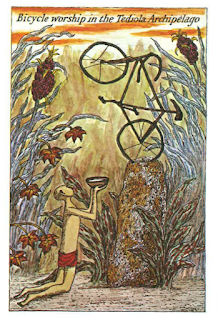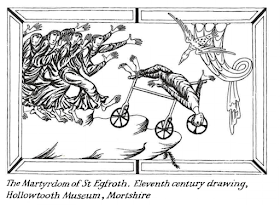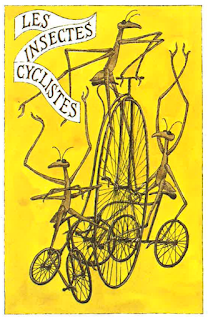Edward Gorey did illustrations for a number of books and authors, but also wrote and illustrated more than 100 books of his own -- books that, at first glance, might take the form of children's books (and I assume that children might enjoy some of them, if the books didn't give them nightmares), but are probably intended more for adults with a taste for the farcical or macabre.
The visual settings for his works are ostensibly Victorian or Edwardian (that's the period from about 1900 up to the beginning of WWI) and it shouldn't be a surprise that bicycles have found their way into a lot of his illustrations. I don't know that Gorey was a particularly avid cyclist or anything (in fact, some of his bicycle drawings would almost indicate otherwise) but they probably fit a sense of the setting he was portraying.
I recently picked up copies of two of Gorey's bicycle-themed books: a first edition copy of The Broken Spoke (1976) and a second edition of The Epiplectic Bicycle (1969).
The Epiplectic Bicycle is an absurd story of two poorly behaved siblings, Embley and Yewbert, who get taken for ride by a bicycle with a mind of its own. A lot of people probably mis-read the title as "Epileptic" -- but it is, in fact, "Epi-PLEC-tic" which comes from the word "epiplexis" which is a type of rhetorical question one asks "in order to chide, express grief, or inveigh." (yeah, I'm getting all English-Major-y, right?)
 |
| The cover art for The Epiplectic Bicycle has a dead alligator on a bicycle. |
 |
| This is one of those instances where I wonder how familiar Gorey was with the form of a bicycle. Or was that a conscious decision -- that a bicycle that pilots itself doesn't need a crank or pedals? |
They encounter dangers and mishaps, are nearly killed more than once . . .
before eventually returning home to find a strange and inexplicable surprise (sorry, I won't reveal it here).
I found a short stop-motion animated film version of The Epiplectic Bicycle, made by Lauren Horoszewski, an MFA student at the University of Connecticut. It's on Vimeo and I can't seem to embed the video here, but the screenshot below should serve as a link to the site. The look of the film captures, in puppets, some of Gorey's original style.
The other book I recently acquired is The Broken Spoke, which is not so much a story, but a collection of "cycling cards" - each about the size of a postcard. I have a sampling of some of the images below:
 |
| The cover of The Broken Spoke. There is no explanation for the broken bicycle shown. There are more inexplicably broken bicycles on the back cover. |
 |
| The bicycle as an article of worship. Why not? |
 |
| Gorey re-creates the style of medieval illuminated religious manuscripts with his bizarre Martyrdom of St. Egfroth. |
 |
| Gorey channels the surrealists in Les Insectes Cyclistes. |
 |
| This reminds me somewhat of Dia de los Muertos. Notice that the Victorian-era lantern puts out a beam of darkness in the fading daylight. |
 |
| Bat-winged demons appear in many of Gorey's illustrations. Why not put one on a bike? |
The Broken Spoke is out of print, but used copies can be found without too much difficulty. The Epiplectic Bicycle was re-printed not too terribly long ago and new copies may still be available - or again, used copies are out there. Both books are contained in the anthology Amphigorey Also, which is still available through Amazon and most other booksellers. Check them out if you get a chance.





Wow, The Broken Spoke looks fun, I will have to keep an eye out for that. I really enjoy absurd art.
ReplyDeleteWolf.
I also am going to keep an eye out for a copy of The Broken Spoke.
ReplyDeleteI think spinning wheels are what makes bikes and the absurd go together.